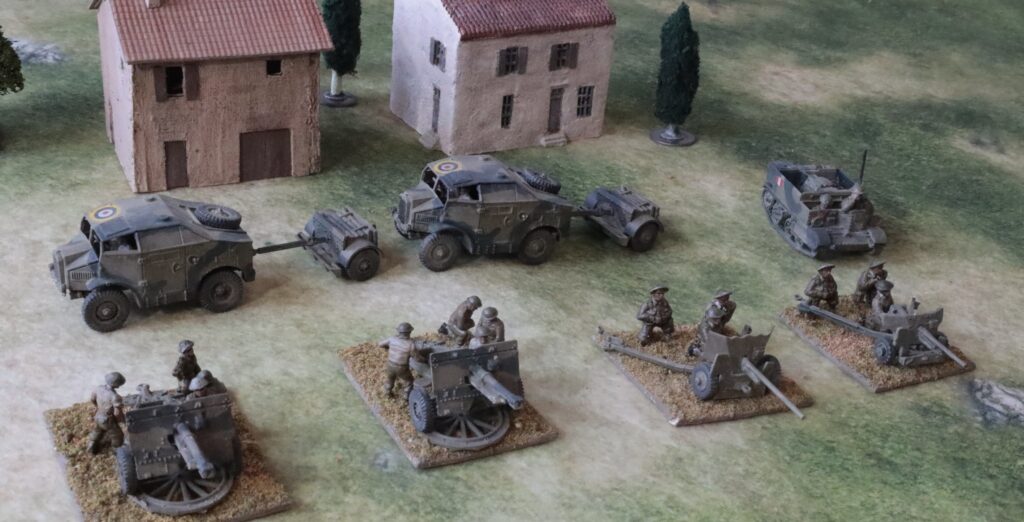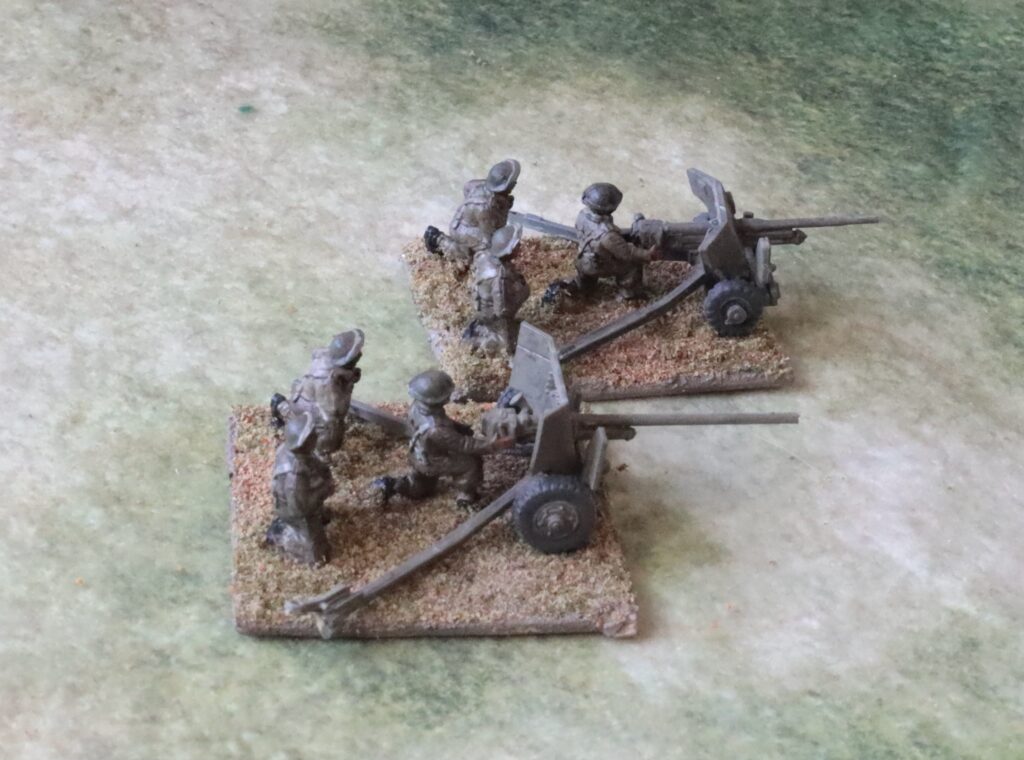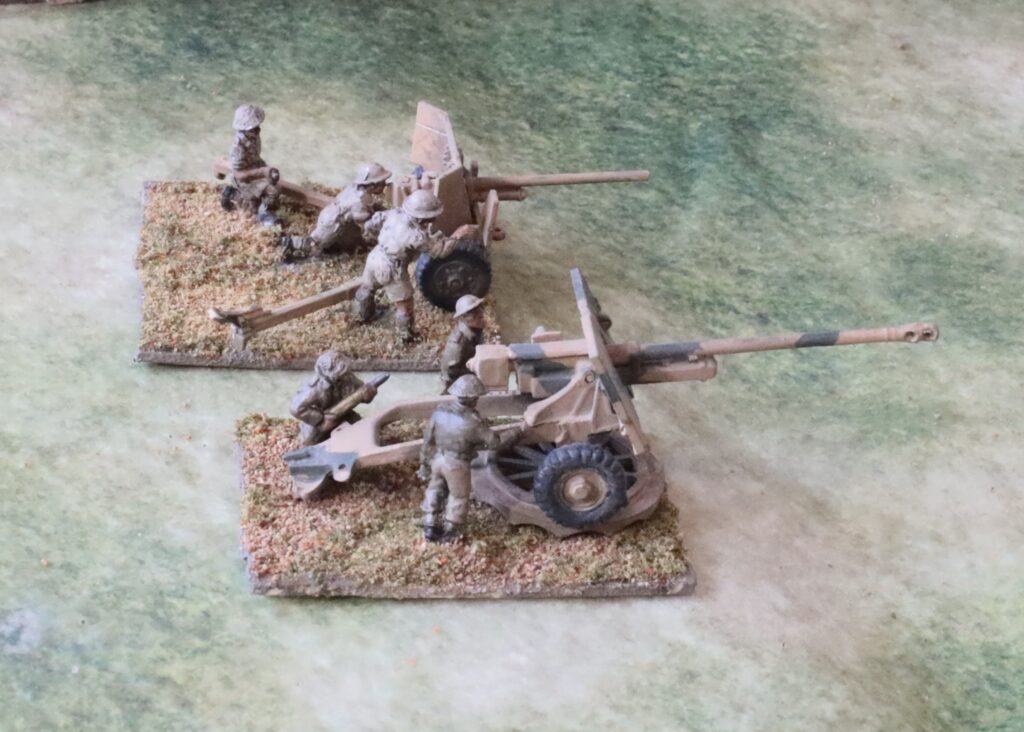
This time I continue with my description most recent batch of figures and models for my 1943 project, as I build up enough forces to run a scenario for Medinine, by talking about the artillery. These comprised two 25-pdrs, three 6-pdrs and a 17-pdr Pheasant. The above picture is of four of the six weapons, together with two Morris Quads and limbers and the carrier OP. These are items I painted in the Light Mud and Blue-Black scheme introduced after Tunisia, ready to be used in Italy. Missing are the two 2-pdrs that I will need, because I didn’t have the models when I started the batch, and found that I needed a second crew assemblage anyway.
Let’s start with the 25-pdrs. These were the workhorses of British artillery in WW2. In the desert, and on at least one occasion in the Tunisian hills, they served as direct fire support, taking on a role as antitank gun. I’m not sure how much of my artillery I will actually use on the tabletop – because even at Rapid Fire scale they would mostly be off the table – though I think Rapid Fire players like to stretch things and put them on. Still I’ve been buying the models: I have two more 25-pdrs and two 5.5in guns in stock, and a number of German guns too. In the Medenine scenario the antitank guns looks a little thin (though more than adequate historically), so I thought it appropriate to have at least a pair of 25-pdrs ready to act as a last line of defence.

I had a box of two 25-pdrs with a Morris Quad in hand (together with another with the CMP Quad, as PSC had run out of the Morris sets). I used this. The first decision was whether to use the parts for the later version, with muzzle-brake. I didn’t have definitive information for when this was introduced. A lot of pictures show the earlier version in North Africa – but there are pictures of the later version in Italy in 1943 (or so the picture captions say) – so I decided to go for this, painted up in the Light Mud and Blue Black scheme. Next was the question of crews. I bought one set of eight figures from AB; I only wanted four on the base, so I hoped to get both crews. But they only had one seated figure, and I thought this was critical – otherwise it would be just a group of people staring at the gun. I decided to use the PSC figures for the second gun. These aren’t nearly as good, but good enough, I think. They supply two versions: Western Desert with men in shorts, and North West Europe with late helmets and scrim. I wanted neither, so I decided to head-swap the African heads onto the later bodies. This wasn’t actually that hard. The AB crew have the later helmets too, but I decided to overlook that (as I have on half of my infantry) – and it wasn’t as blatant as on the PSC figures.
Next come the 6-pdrs:

I needed three more of these to go with my one existing model, one of my old Airfix ones. I had another old Airfix one that just needed a paint job. The cheapest way to source a couple more (with crews) looked to be to get the Valiant models, for which I found a decent review. Alas I think they look wrong, when compared to the photographs in theatre. The Airfix ones look better, though I have no reason to think they are particularly accurate – that wasn’t an Airfix strong point at the time. But it looks low and mean, just like the pictures. A second issue is that I wanted the earlier version of the weapon, with a shorter barrel and no muzzle brake. I followed the advice on the Valiant box, but it just didn’t look right either! I am so dissatisfied that I have bought the PSC box of two 6-pdrs with Loyd carriers, hoping these will look better. The Valiant crew figures were OK, though, and in the right uniform for 1943 – though they are too big. Four were provided, though I only used three. For the third crew I used bought AB desert castings with a crew in shorts, just for variety.
Finally there was the 17-pdr Pheasant. Here it is with the third 6-pdr:

As I said in my previous post, the Pheasant was something of an afterthought. I don’t think that this weapon was used in Medinine, but the 7th Armoured did have them at the time, and they would have been an option for the British. Actually they probably weren’t that suitable. Their big virtue was their range – but if they had opened up at long range (and the 17-pdr went off with a very spectacular flash and bang) they would then have been picked off by the German artillery and mortars. Plus they were bigger weapons, harder to conceal in the desert. This model is one I made back in the 1970s from and Airfix 25-pdr and a Panther gun barrel. Very basic, but I adjudged it good enough. I had plenty of SHQ crew, which I brought into play. These are slightly smaller than AB figures, and so more appropriate for this slightly smaller-scaled model. Here’s a different angle, including the three vehicles I painted in desert camouflage:

I will describe how I painted the models in my next post covering the vehicles. The process for figures I have already described – they were painted alongside the infantry.